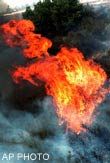Global Warming Fuels U.S. Forest Fires

A recent increase in wildfire activity has been correlated with rising seasonal temperatures and the earlier arrival of spring, a new study concludes.
Looking at a database of 1,166 forest wildfires from 1970 to 2003 in the western United States, researchers compared the number and potency of wildfires to spring and summer temperatures and the timing of snowmelts.
Wildfire season and potency increased "suddenly and dramatically" in the late 1980's, the scientists say.
"The increase in large wildfires appears to be another part of a chain of reactions to climate warming," said study co-author Dan Cayan, director of Scripps Institution of Oceanography's Climate Research Division. "The recent ramp-up is likely, in part, caused by natural fluctuations, but evidence is mounting that anthropogenic effects have been contributing to warmer winters and springs in recent decades."
Fired up
Cayan and colleagues noted that in the mid 1980's there was a jump of four times the average number of wildfires in the West compared with the early 1980's and 1970's. The total area burned was six-and-a-half times greater in the mid 1980's than the earlier years examined. [Graphic: National Acres Burned]
The wildfire season has also extended by 78 days in the more recent period of 1987 to 2003 compared to 1970 through 1986.
Sign up for the Live Science daily newsletter now
Get the world’s most fascinating discoveries delivered straight to your inbox.
The researchers also found that 56 percent of the wildfires and 72 percent of the total burnt area occurred during the years when the snow melted early. When the snowmelt season occurred later than average, only 11 percent of wildfires occurred.
"At higher elevations what really drives the fire season is the temperature. When you have a warm spring and early summer, you get earlier snowmelt," said study coauthor Anthony Westerling of Scripps Institution of Oceanography at the University of California, San Diego. "With the snowmelt coming out a month earlier, areas then get drier earlier overall and there is a longer season in which a fire can be started—there's more opportunity for ignition."
Changing the forest
The increased frequency of large wildfires could reduce the density of trees and change forest landscapes.
The country's western forests, which traditionally act as storage "sinks" for sequestering 20 to 40 percent of all U.S. carbon output, are now transforming into a source of atmospheric carbon dioxide as they burn up, the authors write.
"I see this as one of the first big indicators of climate change impacts in the continental United States," said study coauthor Thomas Swetnam, director of the Laboratory of Tree-Ring Research at the University of Arizona in Tucson. " Lots of people think climate change and the ecological responses are 50 to 100 years away. But it's not 50 to 100 years away—it's happening now in forest ecosystems through fire."
The study is detailed in this week's online version of the journal Science.
- Top 10 Ways to Destroy Earth
- Natural Disasters: Top 10 U.S. Threats
- Scorched West to Sizzle All Summer, NOAA Says
- In a Twist, Forest Products Viewed as Green Energy
- Snow Melting Earlier In Eastern North America
- Drought Lands Doubled
Hot Topic
The Controversy
- Global Warming Differences Resolved
- Conflicting Claims on Global Warming and Why It's All Moot
- Baffled Scientists Say Less Sunlight Reaching Earth
- Scientists Clueless over Sun's Effect on Earth
- Greenhouse Gas Hits Record High
- Key Argument for Global Warming Critics Evaporates
The Effects
- Seas to Rise
- Deserts to Grow
- Greenland Melts
- Ground Collapses
- Glaciers Disappear
- Allergies Get Worse
- Animal DNA Changing
- Animals Change Behavior
- Rivers Melt Sooner in Spring
- Increased Plant Production
- Hurricanes Get Stronger
- Lakes Disappear
The Possibilities
- More Rain but Less Water
- Ice-Free Arctic Summers
- Overwhelmed Storm Drains
- Worst Mass Extinction Ever
- A Chilled Planet
Strange Solutions












